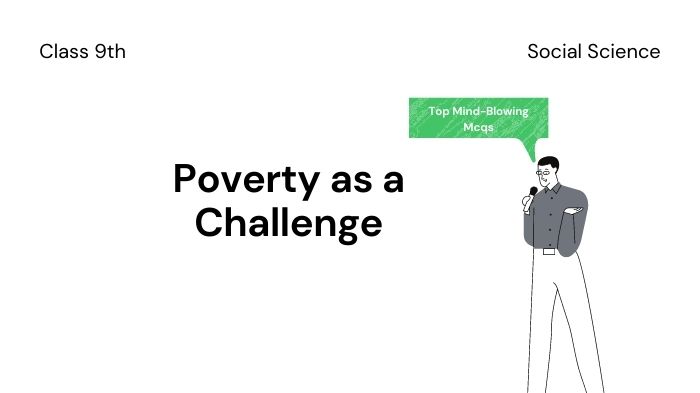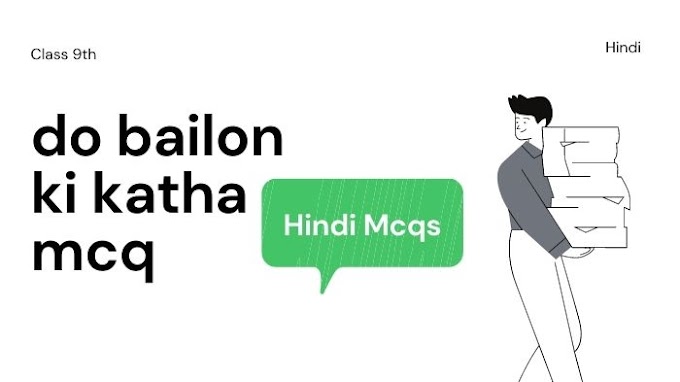
poverty as a challenge class 9 mcq :This is the Top Mind-Blowing mcqs to grow your knowledge. Learn More poverty as a challenge class 9 mcq with this in-depth post.
Questions For poverty as a challenge class 9 mcq
How is poverty commonly measured ?
(A) On the basis of skill or literacy levels
(B) On the basis of health or hygiene levels
(C) On the basis of income or consumption levels
(D) On the basis of social exclusion or vulnerability levels
How are poverty trends in India and the world illustrated through?
(A) The concept of poverty line
(B) Head count ratio
(C) The concept of GDP
(D) Literacy rate
Every ........ person in India is poor.
(A) 100th
(B) 40th
(C) 4th
(D) 7th
How many people in India live in poverty 2011-12 ?
(A) 25 crore / 250 million
(B) 27 crore / 270 million
(C) 2 crore / 20 million
(D) 5 crore / 50 million
Which country has the largest single concentration of the poor in the world?
(A) India
(B) USA
(C) Nigeria
(D) China
Who always insisted that India would be truly independent only when the poorest of its people become free of human suffering ?
(A) Pandit Nehru
(B) Mahatma Gandhi
(C) Abul Kalam
(D) BR Ambedkar
Which of the following statements is true about poverty ?
(A) Poverty line is universally fixed.
(B) Poverty line may vary with time and place.
(C) Poverty line may vary with time but is consistent with place.
(D) Poverty line exists in socialist countries only.
What is the accepted average calorie requirement in India per person per day for rural areas and urban areas?
(A) 816; 1000 respectively
(B) 2100; 2100 respectively
(C) 2400; 2100 respectively
(D) 2100; 2400 respectively
Why are calorie requirements in rural areas considered to be higher than in urban areas ?
(A) Since people living in rural areas engage themselves in more mental work
(B) Since people living in rural areas do not have balanced meals
(C) Since people living in rural areas engage themselves in more physical work
(D) None of the above
In the year 2011-12, the poverty line for a person was fixed at .........per month for rural areas and .........for urban areas.
(A) Rs 870 ; Rs 1500 respectively
(B) Rs 900 ; Rs 2000 respectively
(C) Rs 816; Rs 1000 respectively
(D) None of the above
Which organisation conducts sample surveys to estimate poverty line periodically (normally every five years)?
(A) the National Sample Survey Organisation (NSSO)
(B) Non Governmental aOrganisation (NGO)
(C) The National Poverty Organisation (NPO)
(D) NITI aayog
What is the uniform standard for the poverty line according to the world Bank (2011, ppp) ?
(A) minimum availability of the equivalent of $1.00 per person per day
(B) minimum availability of the equivalent of $1.70 per person per day
(C) minimum availability of the equivalent of $1.90 per person per day
(D) minimum availability of the equivalent of $2.90 per person per day
Which of the following factors is not a social indicator of poverty ?
(A) The levels of income and consumption.
(B) Illiteracy level, lack of general resistance due to malnutrition,
(C) Lack of access to healthcare, lack of job opportunities,
(D) Lack of access to safe drinking water, sanitation etc.
Which of the following would you consider as poor people?
(A) landless labourers in villages or people living in overcrowded jhuggis in cities.
(B) daily wage workers at construction sites or child workers in . dhabas.
(C) beggars with children in tatters.
(D) All the above
Which of the following can be Both a cause as well as a consequence / an effect of poverty?
(A) Social exclusion and indebtedness
(B) Vulnerability and illiteracy
(C) Disease and malnutrition
(D) None of the above
................ to poverty is a measure, which describes the greater probability of certain communities of becoming, or remaining, poor in the coming years.
(A) Social exclusion
(B) Indebtedness
(C) Vulnerability
(D) None of the above
Which of the following social groups are most vulnerable to poverty ?
(A) Scheduled Caste and Scheduled Tribe households
(B) Other Backward Classes households
(C) Casual labourers
(D) None of the above
Who among the members of poor families suffer more ?
(A) Women
(B) Elderly people
(C) Female infants
(D) All the above
Although the average for people below poverty line for all groups in India is 22, ........out of 100 people belonging to Scheduled Tribes are not able to meet their basic needs.
(A) 43
(B) 22
(C) 29
(D) 34
Which of the following states continue to be the two poorest states with poverty ratios of 33.7 and 32.6 per cent respectively.?
(A) Punjab and Haryana
(B) Tamil Nadu and Kerala
(C) Bihar and Odisha
(D) Kashmir and Andhra Pradesh
How States like Punjab and Haryana have traditionally succeeded in reducing poverty ?
(A) with the help of high agricultural growth rates.
(B) focused more on human resource development
(C) land reform measures have helped in reducing poverty
(D) public distribution of food grains
The new sustainable development goals of the United Nations (UN) proposes ending poverty of all types by .......
(A) 2025
(B) 2030
(C) 2035
(D) 2040
Number of poors in China has come down from 88.3 per cent in 1981 to 14.7 per cent in 2008 to .......per cent in 2015.
(A) 9.7
(B) 7.9
(C) 0.7
(D) 11
The proportion of people in different countries living in extreme economic poverty-defined by the World Bank as living on less than $1.90 per day-has fallen from 36 per cent in 1990 to .......per cent in 2015.
(A) 10
(B) 22
(C) 14
(D) 20
Poverty declined substantially in China and Southeast Asian countries as a result of rapid economic growth
(A) massive investments in human
(B) resource development
(C) Both (a) and (b)
(D) None of the above
Poverty has also resurfaced in some of the former socialist countries like.........., where officially it was non-existent earlier
(A) China
(B) Russia
(C) Korea
(D) All the above
The current anti-poverty strategy of the government is based broadly on ........
(A) promotion of economic growth
(B) targeted anti-poverty programmes
(C) Both (a) and (b)
(D) None of the above
Which of the following is a cause of poverty in India ?
(A) low level of economic development under the British colonial administration.
(B) The failure at both the fronts: promotion of economic growth and population control
(C) high level of indebtedness
(D) All the above
What does MNREGA stand for?
(A) Mega National Rights of Employment Guarantee Act,
(B) Mahatma Gandhi National Rights and Employment Guarantee Act,
(C) Mahatma Gandhi National Rural Employment Guarantee Act,
(D) Motilal Nehru National Rural Economy Guarantee Act,
Mahatma Gandhi National Rural Employment Guarantee Act, 2005 aims to provide ......... of wage employment to every household to ensure livelihood security in rural areas.
(A) 100 days
(B) 200 days
(C) 365 days
(D) 5 years
How many proposed jobs have been reserved for women under MNREGA 2005?
(A) 1/2
(B) 1/3
(C) 1/4
(D) 1/5
When was Prime Minister Rozgar Yozana (PMRY) started ?
(A) in 1990
(B) in 1993
(C) in 1999
(D) in 2000
Which of the following programmes aims to provide additional central assistance to states for basic services such as primary health, primary education, rural shelter, rural drinking water and rural electrification?
(A) Rural Employment Generation Programme (REGP)
(B) Swarnajayanti Gram Swarozgar Yojana (SGSY)
(C) Pradhan Mantri Gramodaya Yozana (PMGY)
(D) Antyodaya Anna Yozana (AAY)
Which of the following programmes was launched in 1999?
(A) Rural Employment Generation Programme (REGP)
(B) Swarnajayanti Gram Swarozgar Yojana (SGSY)
(C) Pradhan Mantri Gramodaya Yozana (PMGY)
(D) Antyodaya Anna Yozana
Despite less calorie requirement, the higher amount for urban areas has been fixed because of.......
(A) Low prices of many essential products in urban centres.
(B) high prices of many essential products in urban centres.
(C) Moderate prices of many essential products in urban centres.
(D) None of the above
Among the economic groups, the most vulnerable groups are
(A) Scheduled castes and scheduled tribes
(B) OBCs
(C) the rural agricultural labour households and the urban casual labour households.
(D) None of the above
How can poverty be reduced ?
(A) higher economic growth, increasing stress on universal free elementary education,
(B) declining population growth,
(C) increasing empowerment of the women and the economically weaker sections of society.
(D) All the above
Final Words :
I hope this will help you to grow your knowledge in this poverty as a challenge class 9 mcq.
Read Also :Top Mind-Blowing atoms and molecules class 9 mcq

0 Comments